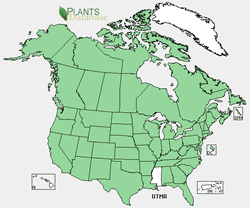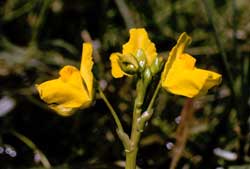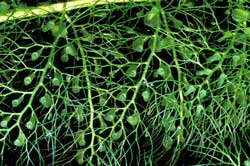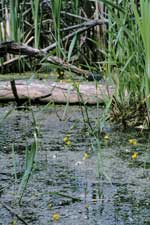Plant of the Week
 Range map of common bladderwort. States are colored green where the species may be found.
Range map of common bladderwort. States are colored green where the species may be found.
 Common bladderwort (Utricularia macrorhiza). Photo by Barry Rice, www.sarracenia.com.
Common bladderwort (Utricularia macrorhiza). Photo by Barry Rice, www.sarracenia.com.
 Bladders that trap prey for Utricularia macrorhiza. Photo by Barry Rice, www.sarracenia.com.
Bladders that trap prey for Utricularia macrorhiza. Photo by Barry Rice, www.sarracenia.com.
Common bladderwort (Utricularia macrorhiza Le Conte)
By Larry Stritch
Common bladderwort is an often overlooked, but remarkable aquatic carnivorous plant with highly divided, underwater leaf-like stems and numerous small "bladders". The flowers, which grow above water, are yellow, two-lipped with a forward facing spur on the lower lip (similar in form to snapdragons).
The "bladders", from which the common named is derived, are used to capture small aquatic organisms. Hairs at the opening of the bladder serve as triggers, and when contacted, mechanically cause the trap to spring open, drawing in water and organisms like a vacuum. Enzymes and /or bacteria inside the traps aid in digestion.
Common bladderwort is native to the Northern Hemisphere, and is known to occur in fifty of the United States. It is found in lakes, interdunal ponds, wet marshes, and rivers and streams; often in water up to 6 feet deep.
 Common Bladderwort in habit. Photo by Barry Rice, www.sarracenia.com.
Common Bladderwort in habit. Photo by Barry Rice, www.sarracenia.com.
Common bladderwort is occasionally used by aquarists in tropical aquariums, but it has a habit of growing quickly and intertwining with other aquatic plants, requiring frequent maintenance.
Several insects, mammals, and waterfowl use common bladderwort as a food source, and others use the stems as shelter, or to lay eggs.
The genus Utricularia is Latin meaning "little bag"; referring to the "bladders" on the stems.

